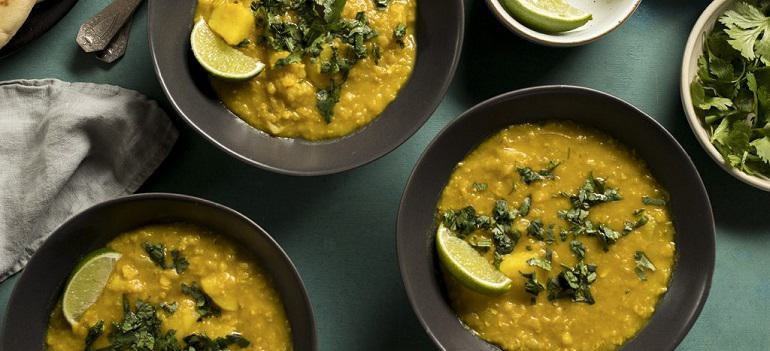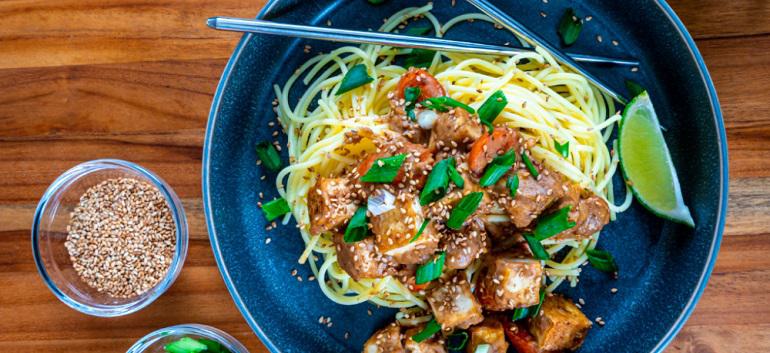


 If you're a fan of Asian food, then you've likely tried delicious curry before. Curry paste and powders are a crucial ingredient in Asian-cuisine, and the flavors often vary depending on the region the dish is from. Southeast Asian curries are commonly based on curry pastes made from several fresh and dried ingredients ground together to make a paste. If you're cooking curries regularly, then creating a paste from scratch is recommended. A homemade paste will be fresh and flavorful. However, it's important to note that curry paste does have a limited shelf life. So, if you're not making curry as often then, purchasing a curry powder or adding in the fresh ingredients later on are the best options.
For a curry recipe that you can make time and time again, try out this Curried Lentil and Sweet Potato Stew. Made with fresh curry paste, it's vegan, gluten free and the perfect addition to your cold-weather recipe collection.
If you're a fan of Asian food, then you've likely tried delicious curry before. Curry paste and powders are a crucial ingredient in Asian-cuisine, and the flavors often vary depending on the region the dish is from. Southeast Asian curries are commonly based on curry pastes made from several fresh and dried ingredients ground together to make a paste. If you're cooking curries regularly, then creating a paste from scratch is recommended. A homemade paste will be fresh and flavorful. However, it's important to note that curry paste does have a limited shelf life. So, if you're not making curry as often then, purchasing a curry powder or adding in the fresh ingredients later on are the best options.
For a curry recipe that you can make time and time again, try out this Curried Lentil and Sweet Potato Stew. Made with fresh curry paste, it's vegan, gluten free and the perfect addition to your cold-weather recipe collection.
 Sesame oil is a flavor that shines throughout Asian dishes. Like soy sauce, there are different types of sesame oil. Sesame oil featuring a dark color has likely been toasted and will have a rich aroma. A clear or yellow-colored sesame oil usually has not been toasted and will have a more mild taste and smell. Adding sesame oil to your favorite Asian dishes, like stir fry, will help give your meal the authentic taste you know and love. That being said, a little goes a long way, and too much sesame oil can quickly overpower the flavor of a meal.
Are you a fan of sesame oil? If so, you'll love these Sesame Noodles With Tofu and Almond Sauce. Fresh ginger, soy sauce and toasted sesame oil are used to flavor this delicious Asian-inspired meal. Or, try our sesame crackers for a satisfyingly crunchy snack!
Sesame oil is a flavor that shines throughout Asian dishes. Like soy sauce, there are different types of sesame oil. Sesame oil featuring a dark color has likely been toasted and will have a rich aroma. A clear or yellow-colored sesame oil usually has not been toasted and will have a more mild taste and smell. Adding sesame oil to your favorite Asian dishes, like stir fry, will help give your meal the authentic taste you know and love. That being said, a little goes a long way, and too much sesame oil can quickly overpower the flavor of a meal.
Are you a fan of sesame oil? If so, you'll love these Sesame Noodles With Tofu and Almond Sauce. Fresh ginger, soy sauce and toasted sesame oil are used to flavor this delicious Asian-inspired meal. Or, try our sesame crackers for a satisfyingly crunchy snack!
 Rice vinegar has a fruity and slightly sweet flavor that is loved by many cultures. While rice vinegar isn't used as often as ingredients like soy sauce, it is a must-have ingredient when making dishes like sweet and sour pork and orange chickensome of our favorites!
Rice vinegar has a fruity and slightly sweet flavor that is loved by many cultures. While rice vinegar isn't used as often as ingredients like soy sauce, it is a must-have ingredient when making dishes like sweet and sour pork and orange chickensome of our favorites!
 Clay pots are a staple when cooking Asian cuisine. Also known as "hot pots," the clay pots used are often glazed on the inside and unglazed on the outside. They are used for baking or stewing. Available in various sizes, the size of the clay pot you choose will largely determine the meals you make most often.
Clay pots are a staple when cooking Asian cuisine. Also known as "hot pots," the clay pots used are often glazed on the inside and unglazed on the outside. They are used for baking or stewing. Available in various sizes, the size of the clay pot you choose will largely determine the meals you make most often.